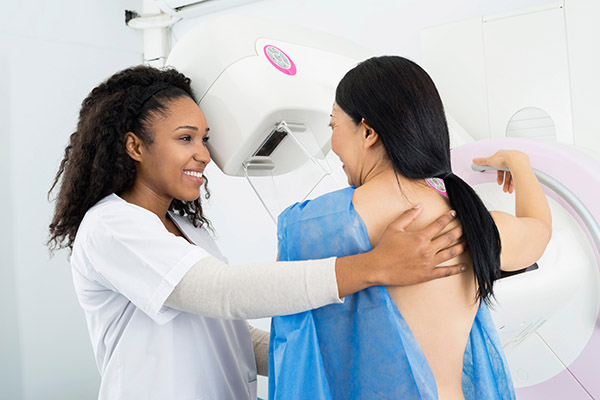The American College of Obstetricians and Gynecologists, the American College of Radiology, the American Cancer Society, and the Society of Breast Imaging recommend starting annual mammograms at age 40. Women who have immediate family members who have dealt with breast cancer should mention it to their physicians to determine if a mammogram should be ordered before age 40.
A mammogram is simply an x-ray of the breast. It has been proven to be the best screening option for early diagnosis of breast cancer. Why, then, do so many women avoid mammograms? Let’s explore this topic by acknowledging our mammogram fears!
Pain
Some women do find the examination to be uncomfortable, especially if they are premenopausal. Many women do not realize that the pain experienced from compression of the breasts is very brief. Taking x-rays should take only seconds in each view. In fact, the entire exam should take only 15 minutes in total. There are ways to diminish any discomfort experienced during your exam if you are concerned with having tender breasts. Schedule your mammogram for the week after your period, and avoid caffeine for 24 hours prior, will help to minimize the discomfort from the compression of the exam significantly.
Radiation
The amount of radiation emitted in a mammogram is very small, less than a standard chest x-ray (.4mSv). To put dose into perspective, people in the US are normally exposed to an average of about 3mSv of radiation each year just from their natural surroundings. This is called background radiation. The dose of radiation used for a screening mammogram of both breasts is about the same amount of radiation a woman would get from her natural surroundings over about seven weeks.
The amount of radiation that touches the rest of the body, called scatter radiation, is minuscule and does not cause any harm. The benefits of mammography clearly outweigh the risks of radiation exposure.
The Unknown
Not knowing what to expect before an exam can be frightening, especially if you’ve been hearing from others or reading online about experiences that other women have had.
Share your concerns with your provider during your annual exam. They can answer questions as well as provide you with information from reliable resources. Share your concerns, especially if you have had previous painful experiences, with your mammographer. Use this time to provide feedback as well.
Possible Abnormal Results
Many women avoid annual mammograms for just this reason. What if they find something wrong? Most findings in screening mammograms are benign; in fact, 90% is considered normal. But fears over a cancer diagnosis can produce overwhelming anxiety for some women. These fears are understandable; however, unfortunately postponing a mammogram over potential bad news can actually prevent early detection of cancer when it is most treatable. Finding breast cancer early reduces your risk of dying from the disease by 25-30% or more. Women are eligible for screening mammograms at the age of 40, or earlier if they are at high risk. So make that appointment, and go.
Solution
Mammography technology has evolved over the years. A 3D mammogram is a more accurate way to screen for breast cancer. Conventional 2D mammograms provide doctors with a 2D image to evaluate the breast. Such a view can be limiting due to overlapping layers of tissue, which can sometimes produce unclear results, false alarms, or worse – cancer being missed.
The Genius 3D mammograms deliver a series of detailed breast images, allowing your doctor to evaluate your breasts layer by layer better. Genius 3D exams are FDA approved, and over 100 clinical studies have shown that by using this technology, doctors can screen for breast cancer with much greater accuracy – regardless of a woman’s age or breast density.
Greater accuracy means better breast cancer detection and a reduced chance of being called back for additional screenings. Any woman who is due to have a traditional mammogram can elect to have a Genius 3D exam. They are covered and paid for by Medicare, as well as a growing number of private insurers. Again, check with your health insurance provider.
The Genius 3D exam is superior to a conventional 2D mammogram which is why many women are switching. Since 2011, over 8 million women in the US have had a Genius 3D exam.
The 3D experience is comparable to a 2D mammogram. With the latest low-dose mammogram technology, the 3D scan takes less than four seconds. It involves a low dose of radiation that is comparable to conventional 2D exams and is well below the safe level set by the FDA.
Consider the difference between looking at a single sheet of paper versus flipping through a book. That is the difference between viewing a 2D and 3D mammogram. Radiologists view “slice after slice” of the breast rather than a single image.
In 2014 alone, more than 200,000 women were diagnosed with an invasive form of breast cancer. That is why innovative screening technology that allows for better, earlier breast cancer detection is critical.
Call SWCWC today to schedule your well-woman exam and your Genius 3D mammogram!

